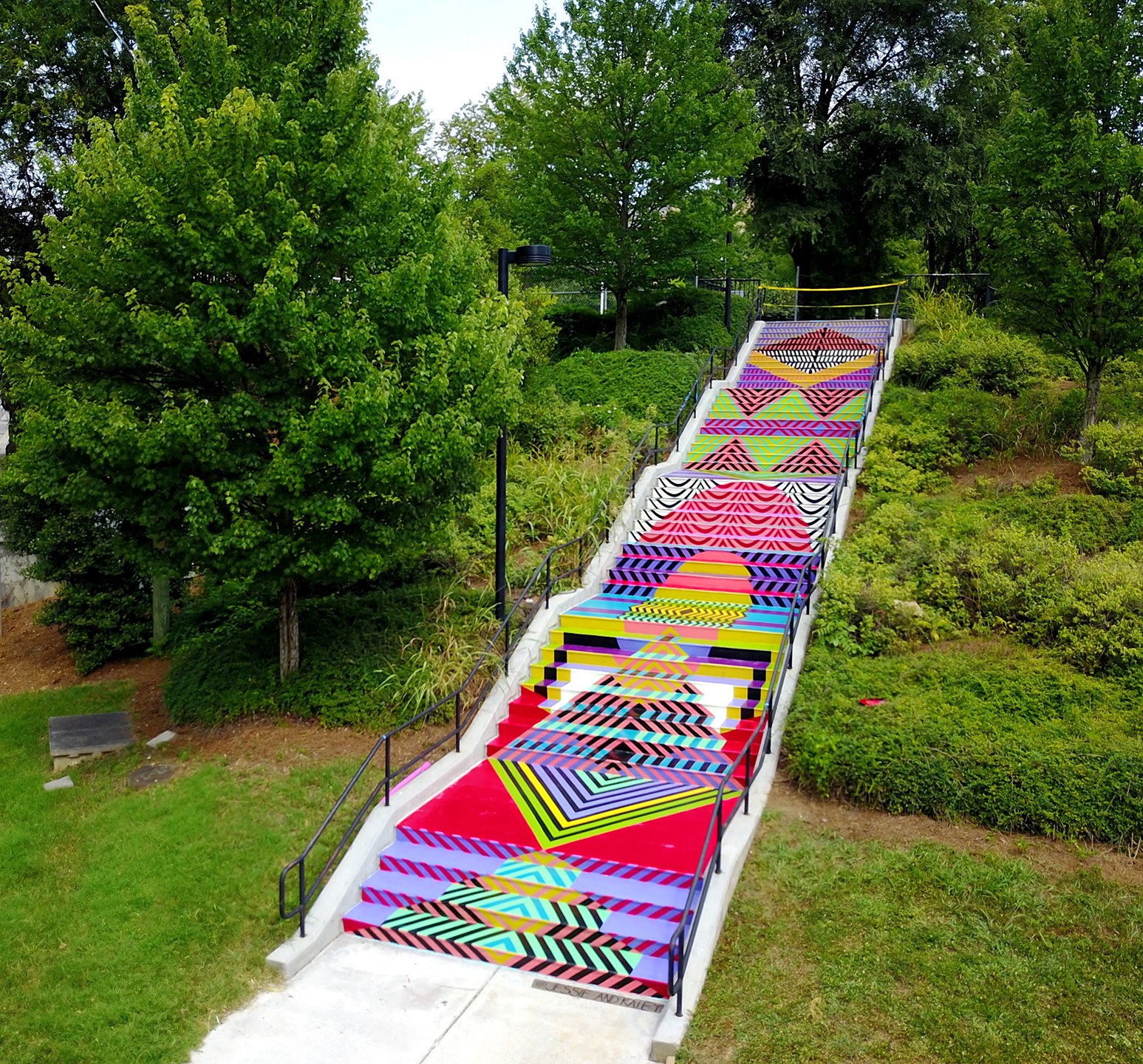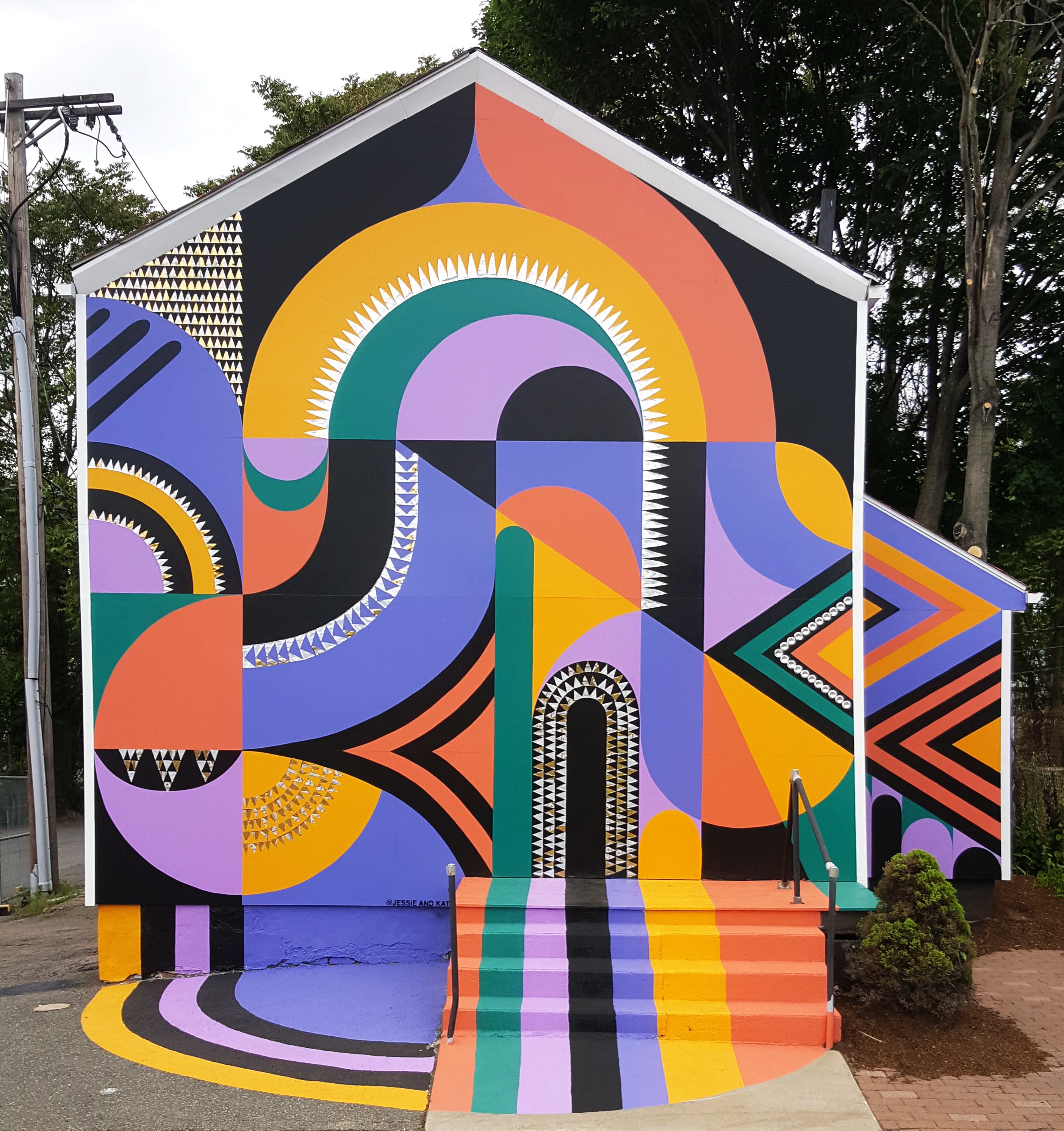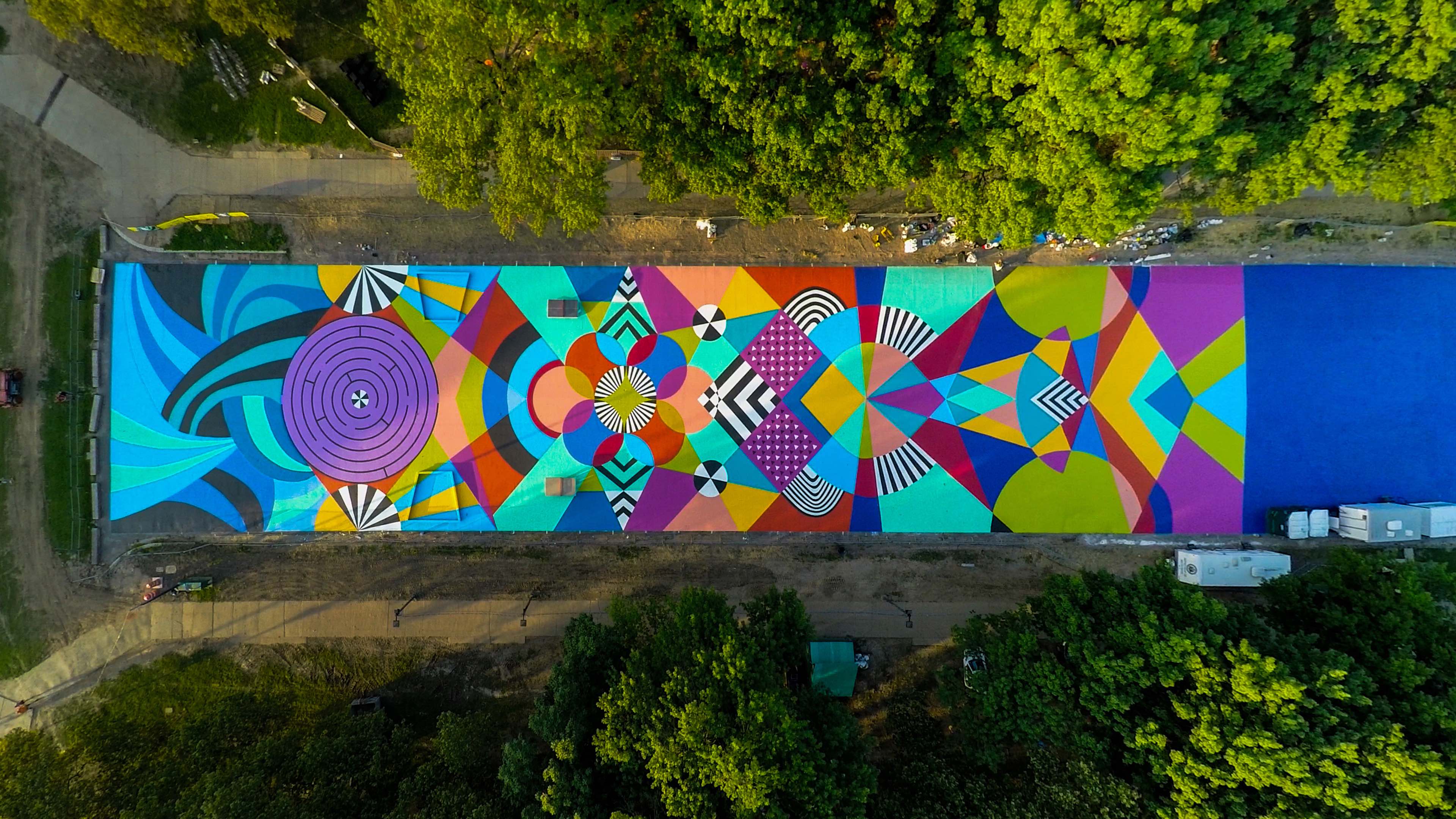“We often describe our work as being like music,” says Jessie Unterhalter, of the art she makes with Katey Truhn. “It’s abstract and it’s fluid. It’s sort of a collaboration of different shapes, like how different sounds collaborate in music. And the fact that we collaborate with each other is pretty cool. We’re a band, basically.”
Better known in the art world as simply Jessie and Katey, the Baltimore-based duo have been creating large-scale public murals, fine art, and sculptures together since 2011 after meeting as students at the Maryland Institute College of Art. Their work is colorful, dynamic, and features geometric abstractions inspired by the surrounding environment, such as their mural for New York City’s 191st Street tunnel or the four-hundred-foot “Summer Kaleidoscope” floor mural they designed for the Eakins Oval in Philadelphia. Jessie and Katey’s murals have been featured in a number of national mural festivals and showcases, and they’ve created several large-scale framed paintings that have been exhibited in Brooklyn, Miami, Baltimore, and Russia.
Chosen by Lollapalooza to design this year’s festival poster, the duo created an abstract design based on a bird’s-eye view of Chicago’s Grant Park, which incorporates permanent park elements like Buckingham Fountain and the harbors of Lake Michigan along with the movement and flow of the Lollapalooza audience. We spoke with Jessie and Katey about creating the poster, the challenges and joys of making art, and (of course) what kind of music they listen to while painting.
 FLOOD: Your Lollapalooza poster reminds me a little of the posters from Chicago’s 1933–34 “Century of Progress” World’s Fair. Were those an influence at all?
FLOOD: Your Lollapalooza poster reminds me a little of the posters from Chicago’s 1933–34 “Century of Progress” World’s Fair. Were those an influence at all?
Katey: Yeah, we looked at those to get a little inspiration—and we pulled the font directly from some of those posters.
FLOOD: How did you hook up with Lollapalooza for this project?
Katey: They actually just sent us an e-mail. I don’t know how they found us, but I think they put us in the running with a couple of artists, and we got chosen, which is rad. That’s pretty much all we know!
FLOOD: Did they give you any direction?
Katey: A little bit… But I think they definitely wanted it to be in our style. The poster had to relate to Chicago in some way. Doing what we do, we kind of abstracted an image of Grant Park.

“Everybody Loves the Sunshine” in Jersey City, NJ
Jessie: We’re public artists—we do really big work in public spaces, transforming environments. So the scale [with the poster] was different for us. But I think we felt drawn to the actual physical nature of the park and using the lines there to work off that environment—that connected our larger, public work to something intimate and small.
Katey: Oh, also, we forgot to mention that we are the first women to design a Lollapalooza poster, which is really cool! That makes us very proud. It’s been going on for a really long time, so that’s kind of surprising.
FLOOD: Had you been to Grant Park before designing the poster?
Jessie: Actually, no. [Laughs.] I know that’s not cool, but…
FLOOD: Well, as a Chicago resident, I think you captured it in a really cool way.
Katey: Thank you. It’s a challenge we face a lot because often our work brings us places we’ve never been. We have to get prepared to make work for that place, so it’s kind of similar.
Jessie: Yeah, you’ve gotta do some research.

“Weaving Rainbow Mountain” in Knoxville, TN
FLOOD: How long did it take you to create the image for this poster?
Katey: It took us a long time, mostly because rendering the file digitally is hard for us, since we work so hands-on. But to come up with the idea, at first, we went through a lot of designs.
Jessie: Yeah, maybe like two or three weeks to figure out what would work, and what we wanted to pull from that would relate to either the music or Chicago. And to find what would make it feel like our style and their style all at the same time—that was kind of a challenge.
FLOOD: Plus, I imagine it must be challenging to create a piece of art that stands by itself, but will also have to serve as a background for a list of band names…
Jessie: We went back and forth with incorporating the band names into the piece, and in the end we added them to the bottom, but we left the other information in the actual composition. I guess our aesthetic is rooted in formalism, and we thought of the typography as their own shapes and forms that we could incorporate. So they became part of the entire piece, and we just left room for all the band names on the bottom.

“Walk the Line” in Baltimore, photo by Martha Cooper
FLOOD: Collaboration in both art and music can be a difficult thing, in that it can be tough to find collaborators who are on the same wavelength. How did the collaboration between you begin?
Katey: Well, we met in college, and we just kind of hit it off. We went to art school, and we learned how to make art alongside each other—so it just seemed like a natural step that we would start collaborating.
Jessie: We didn’t even have to really think about it—or vocalize how it would go. It just sort of happened [laughs].
FLOOD: Do you work to music? Is there any particular music that inspires you?
Jessie: Yeah, we definitely work to music. It just sort of depends on the mood, you know? Sometimes you want something really ambient, and sometimes you want to get pumped up.
Katey: We coined a new term for what we like—Space House Music! I feel like we tend to gravitate toward more spacey techno music. It keeps you going.

“Allumination” in Boston, MA, photo by Jeremy Fraga
Jessie: We like a lot of international music from all over, and just finding anything new we’ve never heard before.
Katey: I think sometimes, too, we get to the point where, when you’re working every day and listening to music the whole time, you really don’t want lyrics getting in the way anymore—you want to not understand something, and be OK with that.
FLOOD: What other projects are you involved in at the moment?
Katey: Right now we’re in Cleveland painting a mural for the Gordon Square community, and we’ve got a couple of other projects this summer—we’re going to San Francisco, Virginia, and Detroit.
FLOOD: Are there any dream projects you’d like to tackle some day?
Jessie: I think [in general] we both want to get more sustainable in what materials we’re using. So maybe using tiles and incorporating plants…

“Summer Kaleidoscope,” in Eakins Oval, Philadelphia, PA
Katey: Stepping away from toxic paint would be a nice move!
Jessie: Today we were talking about how cool it would be if we toured elementary schools and gave math lessons [laughs].
Katey: Surprisingly, we have to do so much math!
FLOOD: Because you’re always having to figure out how to blow your images up to fit larger spaces?
Katey: Yeah, and it’s also geometric. We’re always blown away by how much math we have to do. So we were like, “Art and math… We should teach both of them together.”
FLOOD: Do you typically bring people in to help with your mural projects?
Katey: Yeah, sometimes. It really depends on the project. We try to do it half the time, having people come and help us.
Jessie: It’s more fun that way, and you’re connecting with so many more people from the neighborhood. It enhances the whole experience and makes it feel like you’re connecting with the community. In the end, we go home and the mural stays in their community, so it’s really cool if they can be like, “Oh yeah, we helped paint that!” FL
This article appears in the 2018 FLOOD Festival Guide, presented by SiriusXM and Toyota. You can check out the rest of the magazine here.







